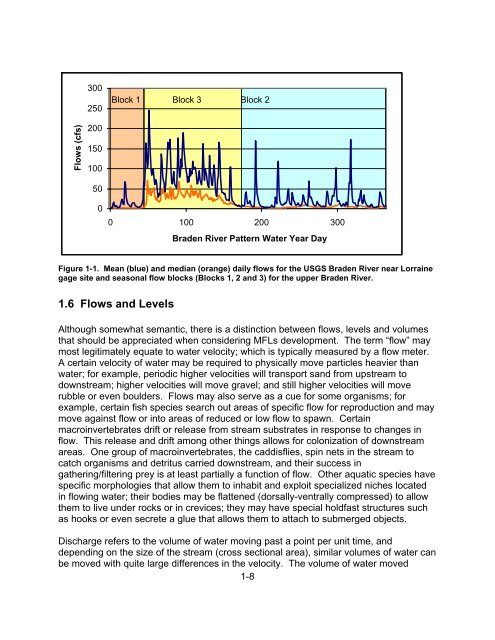Chapter 1 Minimum Flows and Levels - Southwest Florida Water ...
Chapter 1 Minimum Flows and Levels - Southwest Florida Water ...
Chapter 1 Minimum Flows and Levels - Southwest Florida Water ...
You also want an ePaper? Increase the reach of your titles
YUMPU automatically turns print PDFs into web optimized ePapers that Google loves.
300<br />
250<br />
Block 1 Block 3 Block 2<br />
<strong>Flows</strong> (cfs)<br />
200<br />
150<br />
100<br />
50<br />
0<br />
0 100 200 300<br />
Braden River Pattern <strong>Water</strong> Year Day<br />
Figure 1-1. Mean (blue) <strong>and</strong> median (orange) daily flows for the USGS Braden River near Lorraine<br />
gage site <strong>and</strong> seasonal flow blocks (Blocks 1, 2 <strong>and</strong> 3) for the upper Braden River.<br />
1.6 <strong>Flows</strong> <strong>and</strong> <strong>Levels</strong><br />
Although somewhat semantic, there is a distinction between flows, levels <strong>and</strong> volumes<br />
that should be appreciated when considering MFLs development. The term “flow” may<br />
most legitimately equate to water velocity; which is typically measured by a flow meter.<br />
A certain velocity of water may be required to physically move particles heavier than<br />
water; for example, periodic higher velocities will transport s<strong>and</strong> from upstream to<br />
downstream; higher velocities will move gravel; <strong>and</strong> still higher velocities will move<br />
rubble or even boulders. <strong>Flows</strong> may also serve as a cue for some organisms; for<br />
example, certain fish species search out areas of specific flow for reproduction <strong>and</strong> may<br />
move against flow or into areas of reduced or low flow to spawn. Certain<br />
macroinvertebrates drift or release from stream substrates in response to changes in<br />
flow. This release <strong>and</strong> drift among other things allows for colonization of downstream<br />
areas. One group of macroinvertebrates, the caddisflies, spin nets in the stream to<br />
catch organisms <strong>and</strong> detritus carried downstream, <strong>and</strong> their success in<br />
gathering/filtering prey is at least partially a function of flow. Other aquatic species have<br />
specific morphologies that allow them to inhabit <strong>and</strong> exploit specialized niches located<br />
in flowing water; their bodies may be flattened (dorsally-ventrally compressed) to allow<br />
them to live under rocks or in crevices; they may have special holdfast structures such<br />
as hooks or even secrete a glue that allows them to attach to submerged objects.<br />
Discharge refers to the volume of water moving past a point per unit time, <strong>and</strong><br />
depending on the size of the stream (cross sectional area), similar volumes of water can<br />
be moved with quite large differences in the velocity. The volume of water moved<br />
1-8
















